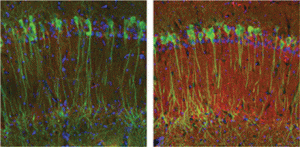What if I told you that it may be possible to live longer than ever while remaining sharp as a tack? Now what if I told you that you’re NOT going to like the key to achieving this immortality?
Ready? To live longer and prosper all you have to do is restrict your calorie intake by at least 30%. That’s it. So kiss that dessert and all future indulgences good-bye! According to several studies conducted in rodents, caloric restriction can increase lifespan by slowing the aging process, preserving brain structure and cognition, and even reducing the occurrence of Alzheimer’s disease pathology. But just as you sink into a deep dark depression over never sampling another Ben & Jerry’s flavor, there may be a light at the end of the tunnel.
Johannes Gräff et al. (2013). A Dietary Regimen of Caloric Restriction or Pharmacological Activation of SIRT1 to Delay the Onset of Neurodegeneration. The Journal of Neuroscience, 33(21): 8951-8960
Adding to the mounting pile of evidence in support of caloric restriction, a recent study conducted by Gräff et al. demonstrated that expression of SIRT1, a protein critically involved in cellular metabolism, stress, and survival mechanisms, reduces neurodegeneration, which is the breakdown of brain cells, caused by aging.
Using a transgenic mouse that experiences neurodegeneration, brain atrophy, and memory loss the authors of the study reduced mouse food intake by 30% and saw protection against synapse loss in the hippocampus, the brain region responsible for memory.
This neurodegeneration is visualized in the image below. Neurons in the hippocampus shown in green and their synapses shown in red are significantly reduced in the transgenic animals without caloric restriction (left) compared to animals undergoing caloric restriction (right).

(source)
Prognosis for the caloric restriction group looks good, showing a significantly greater number of synapses, but how are their brains functioning? Do the increased number of synapses even work properly? Memory task performances of the calorie-restricted mice were also unimpaired compared to mice that that were free to eat as much as they liked. Importantly, SIRT1 activation was also increased in the calorically restricted group of animals.
Great! So calorie restriction seems to be saving the minds of these otherwise doomed mice from dementia through SIRT1 activation, but how does this impact your Rita’s Italian Ice gelato habit?
Well, if SIRT1 is directly involved in keeping our neurons in tip-top shape following caloric restriction, then maybe it’s possible to take caloric restriction out of the equation and deal with SIRT1 directly. And that’s exactly what Gräff and colleagues did.
Instead of undergoing caloric restriction, neurodegenerative mice ingested a SIRT1-activating compound (STAC) and still reaped the aging benefits of caloric restriction without the severe reduction in calorie consumption. Both synapse density and memory scores were improved in the STAC supplement group compared to the control group that did not receive STAC. Bring on the feasts!
While other factors in addition to caloric restriction likely impact longevity, such as diet and exercise, I’ll play the odds and ask for some STAC-laced sprinkles on my next ice cream sundae!
![]() Graff J., Kahn M., Samiei A., Gao J., Ota K.T., Rei D. & Tsai L.H. (2013). A Dietary Regimen of Caloric Restriction or Pharmacological Activation of SIRT1 to Delay the Onset of Neurodegeneration, Journal of Neuroscience, 33 (21) 8951-8960. DOI: 10.1523/JNEUROSCI.5657-12.2013
Graff J., Kahn M., Samiei A., Gao J., Ota K.T., Rei D. & Tsai L.H. (2013). A Dietary Regimen of Caloric Restriction or Pharmacological Activation of SIRT1 to Delay the Onset of Neurodegeneration, Journal of Neuroscience, 33 (21) 8951-8960. DOI: 10.1523/JNEUROSCI.5657-12.2013